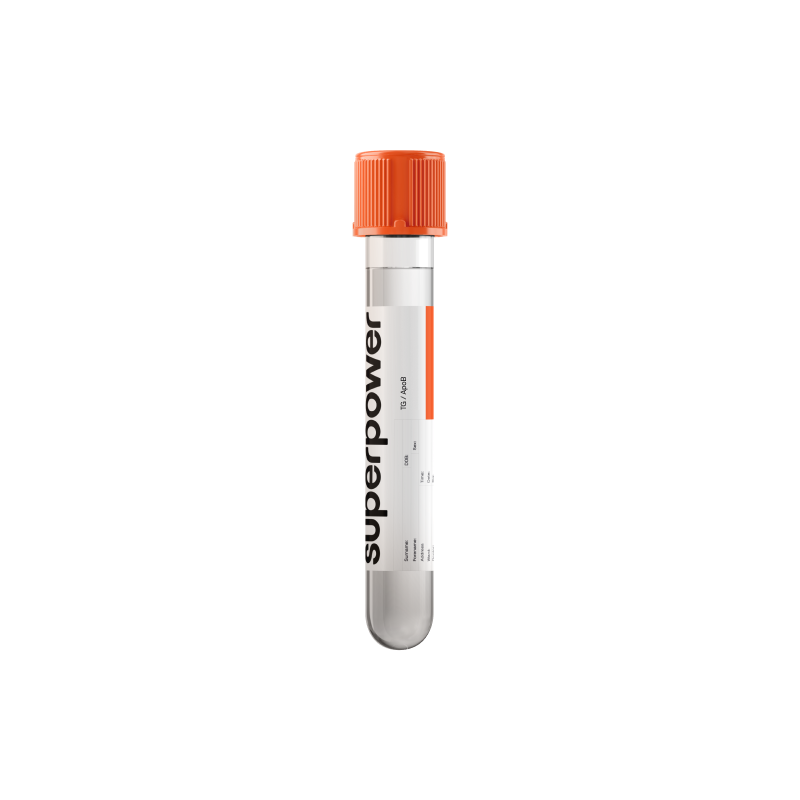Track triglycerides (TG) and ApoB (apolipoprotein B) for clear cardiometabolic insights. Quantify remnant exposure and atherogenic particle number to guide prevention.
Key Benefits
- Know your heart-risk particles and blood fats in one check.
- Spot hidden artery risk; ApoB counts atherogenic particles beyond standard LDL cholesterol.
- Flag insulin resistance; high triglycerides signal metabolic syndrome and diabetes risk.
- Guide treatment intensity; ApoB targets personalize statins, ezetimibe, or PCSK9 therapy.
- Protect against pancreatitis; very high triglycerides require urgent triglyceride-lowering strategies.
- Support fertility and pregnancy; identifying high triglycerides helps reduce gestational pancreatitis and PCOS metabolic risks.
- Track progress; ApoB and triglycerides fall with weight loss, diet, and medication.
- Best interpreted with non-HDL-C, LDL-C, HDL-C, A1c, and your risk factors.
What is TG / ApoB?
TG / ApoB is a ratio that compares the amount of triglyceride in your blood (TG) to the number of ApoB‑containing lipoprotein particles (apolipoprotein B). Triglycerides are energy‑rich fats packaged by the liver and intestine into circulating particles. ApoB is the structural tag present as one copy on each atherogenic particle—VLDL, IDL, LDL, and Lp(a)—so it effectively counts these particles. Together, TG / ApoB describes how much fat cargo is being carried relative to the particle count.
What it reflects is particle composition. The ratio captures the triglyceride enrichment of ApoB particles and the balance between hepatic loading, lipolysis by lipoprotein lipase, and cholesterol–triglyceride exchange via CETP. It integrates VLDL production, VLDL‑to‑LDL remodeling, and the presence of triglyceride‑rich remnants. In short, TG / ApoB links energy transport (triglycerides) to the number of artery‑exposed particles (ApoB), giving an intuitive sense of how much fat each particle carries through the bloodstream.
Why is TG / ApoB important?
TG/ApoB is the triglyceride-to–apolipoprotein B ratio. ApoB counts the number of atherogenic particles (VLDL, IDL, LDL, Lp(a)), while triglycerides reflect how fat-rich those particles are, especially VLDL and remnants. The ratio therefore shows how triglyceride-laden the average apoB particle is—a window into liver fat export, lipoprotein remodeling, insulin signaling, and how “sticky” remnants are to artery walls. It links the heart, liver, pancreas, and vascular endothelium.
There is no universal reference range; labs vary. In general, more favorable values tend to be lower, indicating fewer triglyceride-rich remnants for a given particle number—so long as ApoB itself is not elevated. Middle-to-lower values are often seen with efficient lipolysis and good insulin sensitivity.
When the ratio is on the lower side, it means each apoB particle carries little triglyceride, often reflecting LDL-dominant, cholesterol-rich particles. This can be metabolically “quiet” or, if ApoB is high (as in familial hypercholesterolemia), still atherosclerotic. Symptoms are uncommon; risk resides in particle number and cholesterol enrichment rather than triglyceride load.
When the ratio is higher, particles are triglyceride-rich, signaling hepatic VLDL overproduction and slower clearance—hallmarks of insulin resistance, visceral adiposity, and fatty liver. This pattern raises remnant cholesterol, endothelial inflammation, and, at very high triglycerides, pancreatitis risk. It is more common with obesity, type 2 diabetes, and in pregnancy (physiologic rise in triglycerides); in children and teens, elevation often tracks with excess weight.
Big picture: TG/ApoB integrates particle quantity (ApoB) with composition (triglyceride load), tying together remnant lipoproteins, insulin resistance, NAFLD, and atherosclerosis biology. Interpreted alongside ApoB, non-HDL cholesterol, glucose/insulin markers, and liver enzymes, it refines long-term risks for cardiovascular disease, diabetes, and pancreatitis.
What Insights Will I Get?
What TG/ApoB tells you
TG/ApoB compares blood triglycerides to apolipoprotein B, the protein on each atherogenic particle (VLDL, IDL, LDL). It estimates the triglyceride cargo per particle and therefore hepatic fat export, intravascular fat breakdown (lipolysis), and insulin action—key drivers of remnant load and atherosclerosis risk.
Low values usually reflect little triglyceride per ApoB particle. This occurs with insulin‑sensitive metabolism, efficient lipoprotein lipase activity, and fasting. It can also appear in “pure” hypercholesterolemia, where ApoB is high but triglycerides are normal—yielding a low ratio that actually signals many cholesterol‑rich LDL particles. Children and premenopausal women often run lower.
Being in range suggests balanced VLDL production and clearance, adequate lipase function, and relatively low remnant exposure. Risk tends to be lowest toward the lower‑to‑mid part of typical ranges, as long as ApoB itself is not elevated.
High values usually reflect triglyceride‑rich ApoB particles from greater VLDL output and slower clearance—common with insulin resistance, low thyroid hormone, nephrotic states, or alcohol/estrogen effects. This pattern increases remnant lipoproteins, promotes small dense LDL after lipolysis, and is linked to atherosclerosis and fatty liver. Late pregnancy physiologically raises the ratio.
Notes: Fasting status, acute illness, and triglyceride‑raising drugs (estrogens, steroids, retinoids, protease inhibitors) shift the ratio. Very low ApoB makes it unstable. Assays differ; interpret alongside ApoB, non‑HDL‑C, and triglycerides within your lab’s reference.



.svg)



.png)
.png)
.png)
.png)









.png)